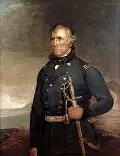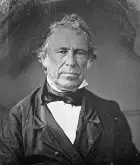Zachary Taylor: War Hero and President
Zachary Taylor was a war hero who became the 12th President of the United States. He is known far more for his achievements as the former than as the latter because he died after only two years in office. Taylor, a second cousin of James Madison and a descendant of Pilgrim leader and Mayflower Compact signer William Brewster, was born on Nov. 24, 1784, near Barboursville, Va., and grew up, for the most part, in Louisville, Kentucky. His parents, who owned a tobacco plantation, had seven other children. Helping the Taylor and their children run the 10,000-acre plantation were more than two dozen slaves. Taylor learned to read and write from his mother because schools on the frontier were few and far between. He did attend one school, operated by a teacher from Connecticut, and then attended an academy in Middletown. 
Taylor knew early in life that he wanted to be a soldier, and he became one, gaining his first command as the leader of the Fort Pickering garrison, near Memphis. He took up command of the Baton Rouge fort in 1810, after he had married Margaret "Peggy" Smith. He and his wife had six children (Ann, Sarah, Octavia, Margaret, Mary Elizabeth, and Richard) and continued the family tradition of owning slaves. He owned 80 slaves who worked a 2,000-acre plantation near Baton Rouge, La; he also owned a plantation in Mississippi. He fought in the War of 1812, defending the Indiana Territory's Fort Harrison against an attack led by the famous Shawnee chief Tecumseh, and then continued his career as a soldier for 40 years, the only exception being a brief resignation following the end of the War of 1812. He helped build forts along the Mississippi River and was part of several struggles involving Americans and Native Americans. He accepted the surrender of Sauk Chief Black Hawk and others at the end of the Black Hawk War in 1832. He won a promotion to brigadier general after defeating a Native American force in the Second Seminole War, in the Battle of Lake Okeechobee, one of the largest such battles of the 19th Century. As a commander, Taylor earned the nickname "Old Rough and Ready" for his willingness to suffer through the drab conditions of the men under his command. In 1841, he was named a commander of the U.S. Army in the West. When the U.S. annexed Texas in 1844, setting off a series of diplomatic rows with Mexico, Taylor established a base nearby, at Louisiana's Fort Jesup. Taylor was at the head of a contingent of troops sent in 1846 to the Rio Grande, to patrol the border. Not long afterward, the Mexican-American War began. 
Mexican troops had crossed the border and set out to besiege select targets in Texas. Taylor proved a successful tactician, defeating Mexican forces at the battles of Palo Alto and Resaca de la Palma and driving them back across the Rio Grande. (After these battles, Taylor ordered that captured Mexican soldiers who were wounded be given the same treatment as wounded American soldiers.) Taylor's troops then invaded Mexico and won key battles at Monterrey (capturing the thought-to-be-impregnable city after just three days) and Buena Vista. This last battle was particularly important because Taylor had disobeyed orders and engaged a larger force commanded by the brilliant Mexican general Antonio LŖpez de Santa Anna. Taylor won the battle but lost his command, surrendering his troops to Major General Winfield Scott. The 1848 Treaty of Guadalupe Hidalgo sealed the peace, resulting the Mexican Cession, a transfer of a large amount of land from Mexico to the U.S. In that year, Taylor ran as a presidential candidate for the Whig Party. (Taylor took a bit of satisfaction from defeating his fellow general Scott for the nomination.) Taylor campaigned on his war hero status and won a narrow victory. His running mate, Millard Fillmore was sworn in as Vice-president on March 5, 1849, when Taylor became President. Taylor, a very religious man, refused to be inaugurated on March 4, which that year fell on a Sunday. He and Fillmore took their respective oaths of office the following day. For a variety of reasons, David Atchison, then President Pro Temp of the Senate was President for a day.. 
As President, Taylor, a Southerner and slave-owner, adopted an anti-slavery stance. Because he saw slavery as economically unviable in the West, he encouraged the abolitionist constitutions written by California and New Mexico, whose residents were applying for statehood. (California became a state in 1850; New Mexico would have to wait a bit.) This angered Southern leaders, who threatened to leave the Union; Taylor's response was that he would lead the army in punishing anyone who broke the laws of the country. This was one of many such threats; the Southern states finally followed through on that promise in 1861. After 16 months in office, Taylor died, suddenly. He had attended a July 4th celebration at the unfinished Washington Monument and, at a blistering-hot celebration, had eaten only cherries, raw vegetables, and milk. He complained of stomach pains for most of a week and died, on July 9, 1850. Doctors listed the cause of death as acute gastroenteritis. (Some sources use the words "cholera morbus," a catch-all term that described such specific non-cholera diseases as dysentery.) Fillmore, following the precedent established by John Tyler after the death of William Henry Harrison just 10 years earlier, became President. Taylor had not achieved much in his short time in office. He did oversee the ratification of the Clayton-Bulwer Treaty, which solidified relations between the U.S. and Great Britain regarding an inter-oceanic canal through Central America. British forces had been taking land in Nicaragua, primarily on the eastern coast, known as the Mosquito Coast. As a result of the treaty, both nations agreed not to claim control of any canal built in Nicaragua. |
|
Social Studies for Kids
copyright 2002–2024
David White


